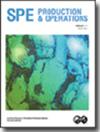An Integrated Genetic-Algorithm/Artificial-Neural-Network Approach for Steady-State Modeling of Two-Phase Pressure Drop in Pipes
IF 1.3
4区 工程技术
Q2 ENGINEERING, PETROLEUM
引用次数: 7
Abstract
Modeling of multiphase flow represents the cornerstone of oil/gas-production systems. Accurate pressure-drop estimation is crucial in the design and operations of subsea architectures. However, the complexity of the underlying physics governing the transport of mass, momentum, and energy considerably limits the accuracy of the current state-of-the-art models. In this paper, we resort to artificial intelligence to develop a unifying artificial-neural-network (ANN) model encompassing all flow conditions. A genetic algorithm (GA) is used to find the optimal input combination from a broad pool of candidates leading to the best prediction accuracy. To train and validate the model, we used the Stanford multiphase-flow database (SMFD). Comprising 5,659 measurements (1,800 of which are actual field data), the SMFD is the largest of its kind encompassing several published data sets. Eighty percent of the data were used to train the model (4,527 measurements) and the remaining 20% (1,132 measurements) were used for validation. The proposed model was compared with two published models, the Beggs and Brill (1973) model, which is widely used in the oil and gas industry, and the Petalas and Aziz (2000) model (a preeminent mechanistic model). The proposed model was proved to significantly increase the prediction accuracy across all pipe-inclination ranges (up to 88%) and also all observed flow patterns (up to 71%). This is a major contribution with potential benefits to the oil and gas industry, where, because of the limited accuracy of the current models, much conservatism is used in the design of subsea architectures, leading to shortfalls of millions in profits.基于遗传算法/人工神经网络的管道两相压降稳态建模方法
多相流建模是石油/天然气生产系统的基石。准确的压降估计在海底结构的设计和操作中至关重要。然而,控制质量、动量和能量传输的基本物理的复杂性极大地限制了当前最先进模型的准确性。在本文中,我们利用人工智能开发了一个包含所有流动条件的统一人工神经网络(ANN)模型。使用遗传算法(GA)从广泛的候选库中找到最佳输入组合,从而获得最佳预测精度。为了训练和验证模型,我们使用了斯坦福多相流数据库(SMFD)。SMFD包括5659个测量值(其中1800个是实际现场数据),是同类测量值中最大的,包括几个已发布的数据集。80%的数据用于训练模型(4527次测量),其余20%(1132次测量)用于验证。将所提出的模型与两个已发表的模型进行了比较,即在石油和天然气行业广泛使用的Beggs和Brill(1973)模型,以及Petalas和Aziz(2000)模型(一个卓越的机械模型)。所提出的模型被证明在所有管道倾斜范围内(高达88%)和所有观测到的流型(高达71%)都能显著提高预测精度。这是对石油和天然气行业的一项重大贡献,对该行业具有潜在的好处。由于当前模型的准确性有限,在海底架构的设计中使用了许多保守主义,导致数百万利润的短缺。
本文章由计算机程序翻译,如有差异,请以英文原文为准。
求助全文
约1分钟内获得全文
求助全文
来源期刊

Spe Production & Operations
工程技术-工程:石油
CiteScore
3.70
自引率
8.30%
发文量
54
审稿时长
3 months
期刊介绍:
SPE Production & Operations includes papers on production operations, artificial lift, downhole equipment, formation damage control, multiphase flow, workovers, stimulation, facility design and operations, water treatment, project management, construction methods and equipment, and related PFC systems and emerging technologies.
 求助内容:
求助内容: 应助结果提醒方式:
应助结果提醒方式:


